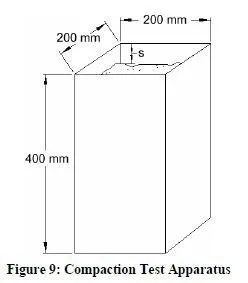The compaction factor test (Powers 1968; Neville 1981; Bartos 1992; Bartos, Sonebi, and Tamimi 2002) measures the degree of compaction resulting from the application of a standard amount of work. The test was developed in Britain in the late 1940s and has been standardized as British Standard 1881-103.
The apparatus, which is commercially available, consist of a rigid frame that supports two conical hoppers vertically aligned above each other and mounted above a cylinder, as shown in Figure 1. The top hopper is slightly larger than the bottom hopper, while the cylinder is smaller in volume than both hoppers. To perform the test, the top hopper is filled with concrete but not compacted. The door on the bottom of the top hopper is opened and the concrete is allowed to drop into the lower hopper. Once all of the concrete has fallen from the top hopper, the door on the lower hopper is opened to allow the concrete to fall to the bottom cylinder. A tamping rod can be used to force especially cohesive concretes through the hoppers. The excess concrete is carefully struck off the top of the cylinder and the mass of the concrete in the cylinder is recorded. This mass is compared to the mass of fully compacted concrete in the same cylinder achieved with hand rodding or vibration. The compaction factor is defined as the ratio of the mass of the concrete compacted in the compaction factor apparatus to the mass of the fully compacted concrete. The standard test apparatus, described above, is appropriate for maximum aggregate sizes of up to 20 mm. A larger apparatus is available for concretes with maximum aggregate sizes of up to 40 mm.

The results of the compaction factor test can be correlated to slump, although the relationship is not linear. Table 5 relates the results of the compaction factor test to slump and the samples degree of workability.
The compaction factor test has been used more widely in Europe than in the United States, although the overall use of the test seems to be declining. The test has typically been used in precast operations and at large construction sites. Compared to the slump test, the apparatus is bulky and a balance is required to perform measurements. In addition to these practical drawbacks, the test has several flaws that reduce the accuracy of the results. Some of the work imparted into the concrete is lost in friction between the hoppers and the concrete. The magnitude of this friction varies between different concrete mixtures and may not reflect fieldconditions. Further, the compaction factor test does not utilize vibration, the main compaction method used in the field (Bartos 1992).
Advantages:
The compaction factor test gives more information (that is, about compactability) than the slump test.
The test is a dynamic test and thus is more appropriate than static tests for highly
thixotropic concrete mixtures.
Disadvantages:
The large and bulky nature of the device reduces its usefulness in the field. Further, the test method requires a balance to measure the mass of the concrete in the cylinder.
The amount of work applied to the concrete being tested is a function of the friction between the concrete and the hoppers, which may not reflect field conditions.
The test method does not use vibration, the main compaction method used in the field.
Although the test is commercially available, it is used infrequently.

